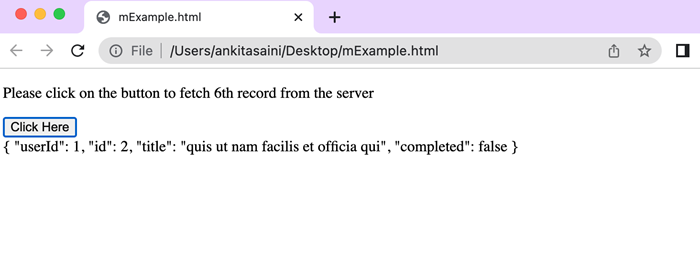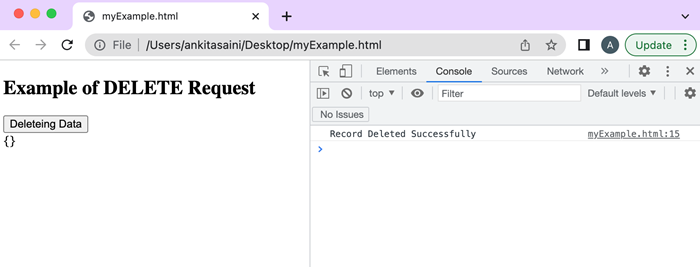
- AJAX Tutorial
- AJAX - Home
- AJAX - What is AJAX?
- AJAX - History
- AJAX - Dynamic Versus Static Sites
- AJAX - Technologies
- AJAX - Action
- AJAX - XMLHttpRequest
- AJAX - Sending Request
- AJAX - Types of requests
- AJAX - Handling Responses
- AJAX - Handling Binary Data
- AJAX - Submitting Forms
- AJAX - File Uploading
- AJAX - FormData Object
- AJAX - Send POST Requests
- AJAX - Send PUT Requests
- AJAX - Send JSON Data
- AJAX - Send Data Objects
- AJAX - Monitoring Progress
- AJAX - Status Codes
- AJAX - Applications
- AJAX - Browser Compatibility
- AJAX - Examples
- AJAX - Browser Support
- AJAX - XMLHttpRequest
- AJAX - Database Operations
- AJAX - Security
- AJAX - Issues
- Fetch API Basics
- Fetch API - Basics
- Fetch API Vs XMLHttpRequest
- Fetch API - Browser Compatibility
- Fetch API - Headers
- Fetch API - Request
- Fetch API - Response
- Fetch API - Body Data
- Fetch API - Credentials
- Fetch API - Send GET Requests
- Fetch API - Send POST Requests
- Fetch API - Send PUT Requests
- Fetch API - Send JSON Data
- Fetch API - Send Data Objects
- Fetch API - Custom Request Object
- Fetch API - Uploading Files
- Fetch API - Handling Binary Data
- Fetch API - Status Codes
- Stream API Basics
- Stream API - Basics
- Stream API - Readable Streams
- Stream API - Writeable Streams
- Stream API - Transform Streams
- Stream API - Request Object
- Stream API - Response Body
- Stream API - Error Handling
- AJAX Useful Resources
- AJAX - Quick Guide
- AJAX - Useful Resources
- AJAX - Discussion
AJAX - Types of Requests
AJAX is a web technology that is used to create dynamic web pages. It allows web pages to update their content without reloading the whole page. Generally, AJAX supports four types of requests and they are −
GET request
POST request
PUT request
DELETE request
GET Request
The GET request is used to retrieve data from a server. In this request, the data is sent as a part of the URL that is appended at the end of the request. We can use this request with the open() method.
Syntax
open(GET, url, true)
Where, the open() method takes three parameters −
GET − It is used to retrieve data from the server.
url − url represents the file that will be opened on the web server.
true − For asynchronous connection set the value to true. Or for synchronous connection set the value to false. The default value of this parameter is true.
Example
<!DOCTYPE html>
<html>
<body>
<script>
function displayRecords() {
// Creating XMLHttpRequest object
var zhttp = new XMLHttpRequest();
// Creating call back function
zhttp.onreadystatechange = function() {
if (this.readyState == 4 && this.status == 200) {
document.getElementById("example").innerHTML = this.responseText;
}
};
// Open the given file
zhttp.open("GET", "https://jsonplaceholder.typicode.com/todos/6", true);
// Sending the request to the server
zhttp.send();
}
</script>
<div id="example">
<p>Please click on the button to fetch 6th record from the server</p>
<button type="button" onclick="displayRecords()">Click Here</button>
</div>
</body>
</html>
Output

In the above example, we are fetching the 6th record from the server using the GET request "https://jsonplaceholder.typicode.com/todos/6" API in XMLHttpRequest. So after clicking on the button, we will get the 6th record from the server.
POST Request
The POST request is used to send data from a web page to a web server. In this request, the data is sent in the request body that is separated from the URL. We can use this request with the open() method.
Syntax
open('POST', url, true)
Where, the open() method takes three parameters −
POST − It is used to send data to the web server.
url − url represents the server(file) location.
true − For asynchronous connection set the value to true. Or for synchronous connection set the value to false. The default value of this parameter is true.
Example
<!DOCTYPE html>
<html>
<body>
<script>
function sendDoc() {
// Creating XMLHttpRequest object
var qhttp = new XMLHttpRequest();
// Creating call back function
qhttp.onreadystatechange = function() {
if (this.readyState == 4 && this.status == 201) {
document.getElementById("sample").innerHTML = this.responseText;
console.log("Data Send Successfully")
}
};
// Open the given file
qhttp.open("POST", "https://jsonplaceholder.typicode.com/todos", true);
// Setting HTTP request header
qhttp.setRequestHeader('Content-type', 'application/json')
// Sending the JSON document to the server
qhttp.send(JSON.stringify({
"title": "MONGO",
"userId": 11,
"id": 21,
"body": "est rerum tempore"
}));
}
</script>
<h2>Example of POST Request</h2>
<button type="button" onclick="sendDoc()">Post Data</button>
<div id="sample"></div>
</body>
</html>
Output

Here in the above example, we are updating the record with the below-given data using the PUT request.
"https://jsonplaceholder.typicode.com/todos/21" API: { "title": "MONGO", "userId": 11, "id": 21, "body": "est rerum tempore" }
DELETE Request
The DELETE request is used to delete data from the web server. In this request, the data to be deleted is sent in the request body and the web server will delete that data from its storage.
Syntax
open('DELETE', url, true)
Where, the open() method takes three parameters −
DELETE − It is used to delete data from the web server.
url − It represents the file url which will be opened on the web server. Or we can say server(file) location.
true − For asynchronous connection set the value to true. Or for synchronous connection set the value to false. The default value of this parameter is true.
Example
<!DOCTYPE html>
<html>
<body>
<script>
function delDoc() {
// Creating XMLHttpRequest object
var qhttp = new XMLHttpRequest();
// Creating call back function
qhttp.onreadystatechange = function() {
if (this.readyState == 4 && this.status == 200) {
document.getElementById("sample").innerHTML = this.responseText;
console.log("Record Deleted Successfully")
}
};
// Deleting given file
qhttp.open("DELETE", "https://jsonplaceholder.typicode.com/todos/2", true);
// Sending the request to the server
qhttp.send();
}
</script>
<div id="sample">
<h2>Example of DELETE Request</h2>
<button type="button" onclick="delDoc()">Deleteing Data</button>
</div>
</body>
</html>
Output

Here in the above example, we delete the record present on Id = 2 using the DELETE request "https://jsonplaceholder.typicode.com/todos/2" API.
AJAX also support some other request like OPTIONS, HEAD, and TRACE but they are the least commonly used requests by the AJAX applications. Now in the next article, we will see how AJAX handle responses.
To Continue Learning Please Login